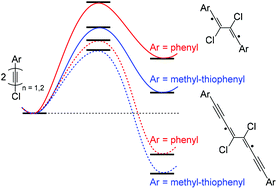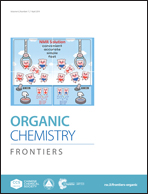Dimerization of substituted 4-aryl-1,3-diacetylenes – quantum chemical calculations and kinetic studies†
Abstract
Dimerization of substituted acetylenes is a very interesting tool to generate 1,3-butadiene 1,4-diradicals. Recently, we were able to show that substituents directly attached to the reaction centers as well as aryl systems have a great influence on the reaction barrier of the dimerization of arylacetylenes. Here, we investigate the dimerization of 4-aryl-1,3-diacetylenes by means of quantum chemical calculations and experimental studies. The focus of the study lies on the second acetylenic unit and the electronic nature of the aryl substituent. Both quantum chemical calculations and kinetic studies reveal that introducing a second alkyne unit accelerates the dimerization reaction by a factor of about 900 while the stabilizing effect on the diradical intermediate is even larger. The activation energy decreases with increasing donor ability of the aryl system. Moreover, it is found that the influence of the aryl system on the activation energy is not significantly smaller for the 4-aryl-1,3-diacetylenes compared to the corresponding arylacetylenes, although the distances between the aryl groups and the radical centers are larger in the 4-aryl-1,3-diacetylenes.

- This article is part of the themed collection: In celebration of Julius Rebek’s 75th Birthday


 Please wait while we load your content...
Please wait while we load your content...